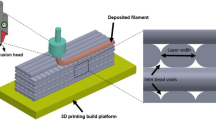Abstract
The present paper analyses the plate drawing processes carried out in converging dies using theoretical work-hardening materials. The analysis has been carried out by the upper bound method (UBM), modelling the plastic deformation zone by triangular rigid zones (TRZ) and considering that the processes occur under plane strain and partial friction conditions. Explicit expressions for the calculation of the necessary power and the non-dimensional total energy to carry out the process using theoretical work-hardening materials have been established. The results have been compared with those obtained using rigid-perfectly plastic materials. In spite of the fact that the energy involved in the process using a work-hardening material is higher than when a rigid-perfectly plastic material is used, the number of possible sets of variables (die geometries, cross-sectional area reductions and partial friction coefficients) increases, since the stability limit of the process increases as well.
Similar content being viewed by others
References
Tian H, Kang D (2003) A study on determining hardening curve for sheet metal. Int J Mach Tool Manu 43:1253–1257
Choi JC, Choi Y (1998) A study on the forging of external spur gears: upper-bound analyses and experiments. Int J Mach Tool Manu 38(10–11):1193–1208
Rao KP, Doraivelu SM, Gopinathan V (1982) Flow curves and deformation of materials at different temperatures and strains rates. J Mech Work Tech 6:63–88
Hill R (1950) The mathematical theory of plasticity. Oxford University Press, London
Avitzur B (1983) Handbook of Metalforming Processes. Wiley, New York
Avitzur B (1980) Metal forming: the application of limit analysis. Marcel Dekker, New York
Talbert SH, Avitzur B (1996) Element mechanics of plastic flow in metal forming. Wiley, New York
Oxford WF, Caddell RM (1983) Metal forming. Mechanics and metallurgy. Pretince Hall, Upper Saddle River
Johnson W, Mellor PB (1983) Engineering plasticicty. Ellis Horwood, Chichester
Rowe GW (1979) Elements of metalworking theory. Edward Arnold, London
Rubio EM, Sebastián MA, Sanz A (2003) Mechanical solutions for drawing processes under plane strain conditions by the upper bound method. J Mater Process Tech 143–144(20):539–545
Rubio EM, Domingo R, González C, Sanz A (2004) Comparative analysis of triangular rigid zones models in the mechanical study of the drawing process by upper bound. Rev Metal Madrid 40(2):90–100
Rubio EM, Domingo R, Arenas JM, González C (2004) Energetic analysis of the drawing process by upper-bound techniques. J Mater Process Tech 155–156:1220–1226
Rubio EM, Camacho AM, Domingo R, González C (2004) Comparative analysis of numerical models of drawing processes under plain strain conditions. In: R. Teti (ed) CIRP Intelligent Computation in Manufacturing Engineering - 4. Salerno (Italy), pp 301–304
Rubio EM, Camacho AM, Sevilla L, Sebastián MA (2005) Calculation of the forward tension in drawing processes. J Mater Process Tech 162–163C:551–557
Camacho AM, Domingo R, Rubio EM, González C (2005) Analysis of the influence of back-pull in drawing process by the finite element method. J Mater Process Tech 164–165C:1167–1174
Camacho AM, Rubio EM Marcos M, González C (2005) Modelling of die shape in drawing process simulation by the finite element method. International Federation of Automatic Control. IFAC-MIM’04. IFAC Conference on Manufacturing, Modelling, Management y Control, Ed. Elsevier, Amsterdam 120–126
Camacho AM, Rubio EM, Sebastián MA (2005) Optimization of die shape in drawing processes. Proceedings of the International Conference on Technology of Plasticity, Ed. Università degli studi di Padova, Verona (Italy) 1–8
Hollomon JH, Jaffe LD (1945) Time-temperature relationships in tempering steel. Trans Metal Soc AIME 162–223
ASM (1985) Mechanical testing, metals handbook 8. ASM International Metals Park, Ohio
Yang DY, Kim YG, Lee CM (1991) An upper-bound solution for axisymmetric extrusion of composite rods through curved dies. Int J Mach Tool Manu 31(4):565–575
Shivpuri R, Chou PC (1989) A comparative study of slab, upper bound and finite element methods for predicting force and torque in cold rolling. Int J Mach Tool Manu 29(3):305–322
Bhutta MA, Chitkara NR (2001) Dynamic forging of splines and spur gear forms: a modified upper bound analysis that includes the effects of inertia and some experiments. Int J Adv Manu Tech 18(3):176–192
Lu YH (2006) Integration of RP and explicit dynamic FEM for the visualization of the sheet metal forming process. Int J Adv Manu Tech 28(3–4):255–261
Dixit US, Chandra S (2003) A neural network based methodology for the prediction of roll force and roll torque in fuzzy form for cold flat rolling process. Int J Adv Manu Tech 22(11–12):883–889
Tai CC, Lin JC (1998) The optimisation deep-draw clearance design for deep-draw dies. Int J Adv Manu Tech 14(6):390–398
Malayappan S, Narayanasamy R (2004) An experimental analysis of upset forging of aluminium cylindrical billets considering the dissimilar frictional conditions at flat die surfaces. Int J Adv Manu Tech 23(9–10):636–643
Author information
Authors and Affiliations
Corresponding author
Rights and permissions
About this article
Cite this article
Rubio, E.M., Marín, M., Domingo, R. et al. Analysis of plate drawing processes by the upper bound method using theoretical work-hardening materials. Int J Adv Manuf Technol 40, 261–269 (2009). https://doi.org/10.1007/s00170-007-1347-7
Received:
Accepted:
Published:
Issue Date:
DOI: https://doi.org/10.1007/s00170-007-1347-7




